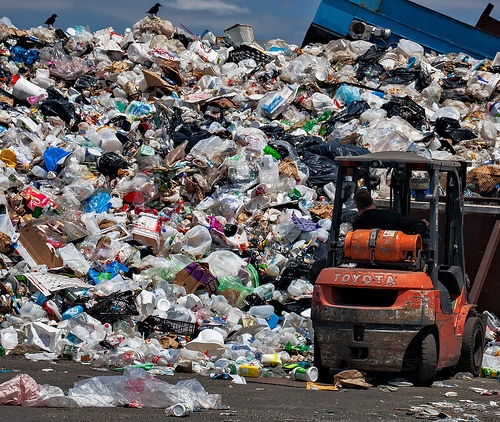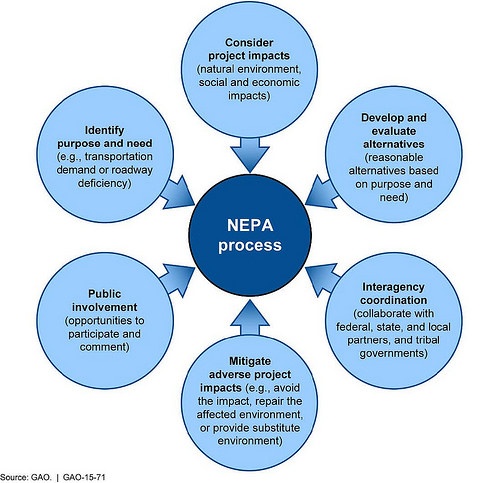On May 30, the Environmental Protection Agency (EPA) repealed a number of regulations governing recycling of secondary materials, which EPA adopted as parts of a major rulemaking effective July 2015, but which were rejected by a federal court in decisions issued in July 2017 and March 2018. These rules apply the Resource Conservation and Recovery Act (RCRA) by creating exemptions from the “Definition of Solid Waste” to define a number of potentially hazardous wastes as “hazardous secondary materials”, and to establish special rules to allow generators and qualified third parties to recycle and recover qualifying materials. (I summarized the larger 2015 rules here). The remainder of this note identifies EPA’s latest changes.
Read MoreAudit, Compliance and Risk Blog
Tags: Environmental risks, Environmental, Hazcom, RCRA
Is it Time to Change How Federal Agencies Review Environmental Impacts?
Posted by Jon Elliott on Tue, Jul 03, 2018
The National Environmental Policy Act (NEPA) of 1969 requires federal agencies to assess the environmental effects of their proposed actions, and incorporate this information into their decisions. Agencies have each adopted their own review regulations, which focus on the search for “significant impacts,” and on alternatives and mitigation measures that will allow an agency to accomplish its goals. This all sounds good, but what does it all mean? For example, which impacts might be “significant?” How many alternatives should be considered, with what attendant costs and benefits?
Read MoreTags: Environmental risks, Environmental
EPA Promulgates “Back-to-Basics” Process for Reviewing Air Quality Standards
Posted by Jon Elliott on Tue, Jun 26, 2018
On May 9, Environmental Protection Agency (EPA) Administrator Chris Pruitt issued a policy memo recasting his agency’s basic approach to review and revision of national ambient air quality standards (NAAQSs) – EPA’s broadest and most basic targets for national pollution levels. He entitles it a “Back-to-Basics” Process for Reviewing [NAAQSs]”, echoing the phrase he used last year to recalibrate the agency’s relationships with the public and its various stakeholders. (I blogged about this general policy here).
Read MoreTags: Environmental risks, Environmental, Greenhouse Gas, ghg, CAA, mact
A Beaver’s Tale: Lessons Learned at Cuyahoga Valley National Park
Posted by Rebecca Luman on Tue, Jun 05, 2018
Growing up, my mother was instrumental in our family of eight taking camping trips each summer. By the time I was in 4th grade, I had been in 42 states, Canada and Mexico, and had never been on a plane. We explored, hiked, and camped in state parks, national parks, and forests, traversing the country, with a pop-up camper and a paper road map to navigate our journeys.
Read MoreTags: Health & Safety, Environmental risks, Environmental, clean water, site auditing
Many of the items that make their way into your home are designed with only one purpose in mind. After you’ve opened up a bottle of champagne, the cage and cork become destined for the landfill. Once you’ve eaten all of the fruit out of the colourful plastic mesh bag, it can’t be recycled and it’s pushed into the trash bin. You can sit around getting blue about all the waste that abounds or you can do what I do and give those items a second chance at life.
Read MoreTags: Business & Legal, Environmental risks, Environmental, Hazcom, climate change, sustainability
EPA Decides to Revise 2022-2025 Automobile GHG Emission Standards
Posted by Jon Elliott on Tue, May 22, 2018
On April 2, the US Environmental Protection Agency (EPA) announced that it has completed its “midterm evaluation” of greenhouse gas (GHG) emissions standards for cars and light trucks for model years 2022-2025, has decided to withdraw standards agreed to between the Obama Administration and California during 2016, and will conduct additional rulemaking to consider less stringent standards. This review began in March 2017, soon after President Trump appointed Scott Pruitt as EPA administrator with a mandate to reduce regulation. California, which has special authority under the federal Clean Air Act (CAA), is leading a coalition of states that has already sued to stop the change. In response to this push-back, President Trump has ordered federal agencies to negotiate with California to seek a compromise.
Read MoreTags: Environmental risks, Environmental, EPA, Greenhouse Gas, ghg
EPA’s Data Transparency Proposal – Secrets are in the Eye of the Beholder
Posted by Jon Elliott on Thu, May 03, 2018
On April 30, the US Environmental Protection Agency (EPA) published a proposed rule (40 CFR part 30) to “strengthen transparency in regulatory science” by requiring the agency to make the data and models used for significant regulatory decisions available for public and peer review. Like most things regarding EPA these days, the proposal has generated significant controversy – based to a large extent to whether the commenter puts more trust in the proposed system and today’s EPA, or in the existing system and yesterday’s EPA. In the remainder of this blog I’ll discuss what’s nominally involved, and possible adjustments to narrow the opportunities for manipulation by tomorrow’s EPA.
Read MoreTags: Environmental risks, Environmental, EPA
The Resource Conservation and Recovery Act (RCRA) assigns the US Environmental Protection Agency (EPA) to define and then regulate “hazardous wastes.” RCRA provides EPA considerable discretion, and one way the agency applies that discretion is by separating hazardous wastes into a variety of categories that are subject to distinct waste management requirements. One basis for these categorizations is relative risk – the more hazardous the waste the greater the controls required, and the smaller the threshold quantities necessary to trigger regulation. Beginning in 1995, EPA has defined a limited set of lower-risk wastes as “universal wastes” subject to special rules intended to encourage recycling (40 CFR part 273). In March 2018, EPA proposed to add aerosol cans. The rest of this note summarizes universal waste requirements, and how EPA is proposing to apply them to aerosol cans.
Read MoreTags: Environmental risks, Environmental, EPA, Hazcom
A lot of time is spent shopping for the right look and for fashion that will flatter or get attention, but are we spending our dollars wisely to make sure that the clothes we wear today will not damage the environment in other parts of the world or in our own backyards tomorrow?
Read MoreTags: Environmental risks, Environmental, Hazcom, sustainability, corporate social responsibility
Administration Proposes Massive Cuts in EPA for Fiscal Year 2019
Posted by Jon Elliott on Tue, Mar 27, 2018
On February 12, the Trump Administration issued its budget proposal for federal Fiscal Year (FY) 2019 (October 1, 2018 through September 30, 2019), subtitled “An American Budget”. The proposal included a 34% cut in the Environmental Protection Agency (EPA) budget, from $8.2 billion in FY 2016 (stable in FY 2017 and FY 2018 under a Continuing Budget Resolutions rather than a fully-new federal budget), to $5.4 billion for FY 2019, with corresponding personnel cuts from 15,408 full-time-equivalent employees (FTE) to 12,250. (these are numbers for EPA in the government-wide budget from the Office of Management and Budget (OMB); the stand-alone budget document on EPA’s website cites $6.1 billion).
Read MoreTags: Business & Legal, Environmental risks, Environmental, EPA, climate change










